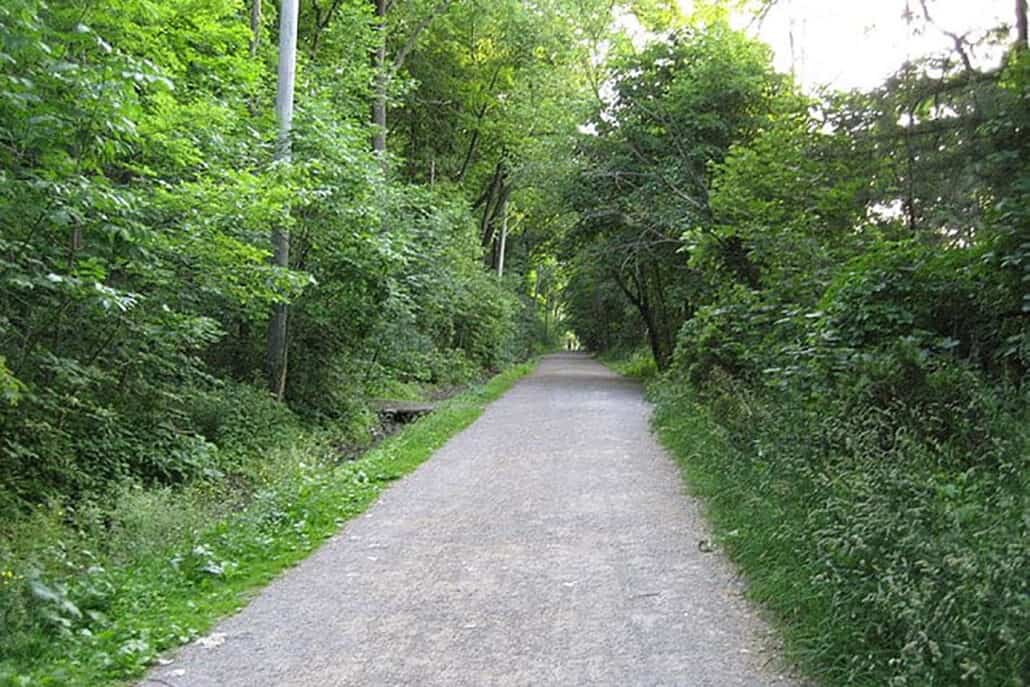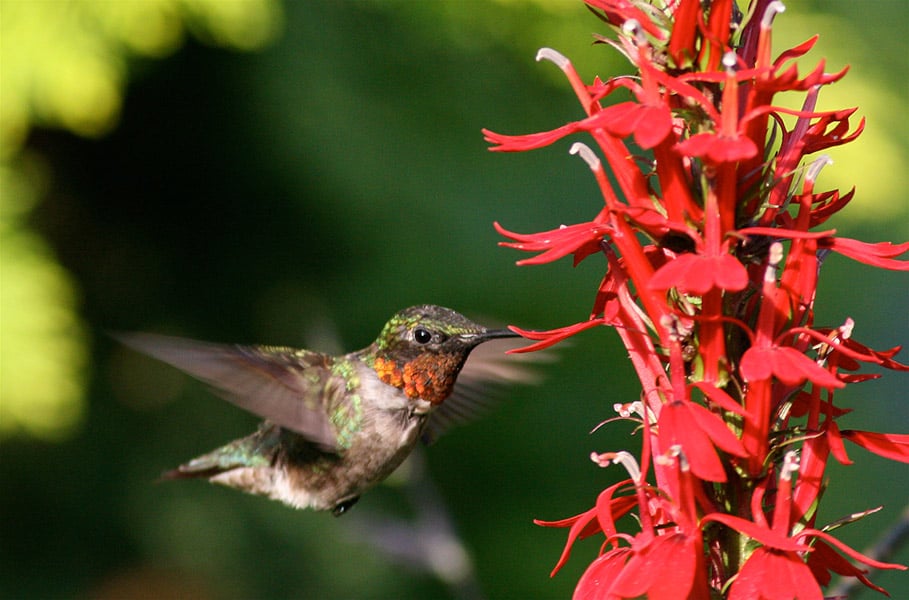Imagine following a gently sloping pathway beside a rushing stream on a sunny spring morning. You’re ambling along a forested hillside, thick with underbrush, and the only break in the forest is a small fenced meadow across the stream.
Suddenly you hear chickadees and kinglets up high in the trees. Then the warblers and vireos quickly arrive overhead, darting among the leaves, deftly plucking small green worms, circling tree trunks and limbs in search of insects. The whole canopy is a swarm of bright yellow birds in motion. The songs of Canada, magnolia, black-throated green, hooded, black-and-white, yellow-throated, and black-throated blue warblers blend in a symphony of sound.
As quickly as it came, the flock moves through the trees downstream. Along the Greenbrier River in West Virginia on a May morning, birding couldn’t be any better than this. You know there’ll be another flock of migrants not far upstream.
The pathway alongside the Greenbrier River is a small section of a vast trail network sponsored by the Rails-to-Trails Conservancy (RTC) that touches every state. The trails are generally linear, rather than circular loops, which follow abandoned railroad beds. The network also includes canal towpaths and greenways (pathways, often in urban settings, that are reserved for recreational use and follow streams or other natural settings).
Since 1986, the RTC has championed the transition of unused rail corridors to public use trails and today there are more than 1,000 rail-trails, with many more projects on the drawing boards. The trails are usually crushed stone surfaces perfect for hiking, biking, horseback riding, skating, jogging, or reaching a favorite fishing hole. Some of them are paved; ideal for skaters. Any non-engine-powered locomotion is welcome on the trails.
Diverse Habitats
The beauty of the trail network is its varied landscapes: unique vistas no matter where you choose to travel. There are rail-trails in the Smoky and Rocky Mountains, the Atlantic and Pacific seashores, the Great Lakes, Midwest prairies, and Southwest deserts. You can find rail-trails in urban settings and wilderness areas.
Rail-trails will take you through many different habitats. Depending where you choose to embark, you can visit almost any forest environment: pine forests in the Southeast, maritime forest along the oceans, very birdy deciduous tracts of the eastern states and redwoods in northern California and southern Oregon. Many rail-trails follow valleys with rivers and creeks, and some skirt wetlands and picturesque mangrove swamps. Most trails pass through a rich mix of habitats that are home to both migratory breeding species and local residents.
Easy Going
The rail-trails are easy to navigate because of their surfaces. Many have stretches of paved or asphalt surface; most surfaces accommodate thin bicycle tires as well as hiking shoes. Wheelchairs can easily maneuver along many of the rail-trails.
Best of all, birders will find that the gentle grades of the rail-trails are kind to bothersome ankles and knees. Even in the steepest mountains, the converted pathways hug hillside contours and maintain moderate uphills and downhills by tunneling through mountainsides and spanning deep ravines and raging rivers on sturdy trestles. Even birders with considerable joint difficulties can travel on most rail-trails easily.
Whether you’re planning a weekend of birding or a vacation destination to a distant hotspot, it’s easy to include a trek on rail-trails. You’ll most likely find a rail-trail near your home, and there are many along heritage routes, near national parks and wildlife refuges, and far from signs of civilization.
A Special Treat
Here’s how I worked a couple of rail-trail visits into planned family activities. Our family, spread across the country, gathered in West Virginia for a spring reunion, and I located the Greenbrier River rail-trail just minutes from our destination. The trail stretches 77 miles through mountains and valleys, with trailheads near the towns of Lewisburg and Cass. A young nephew and I spent early mornings birding along the riverbank while other family members slept in.
While accompanying my spouse on a business trip to Duluth, Minnesota, I spent mornings on the Willard Munger State Trail, the longest paved trail in the world. The section between Duluth and Hinckley passes through several state parks and forests, and the varied trail habitats brought me close to many of the winter specialties characteristic of the northern forests and streams.
Resources
The Rails-to-Trails Conservancy has several resources that will aid your planning. On the RTC’s website, you’ll find a comprehensive directory of 1,000 trails throughout the United States, as well as guidebooks to trails in California, Florida, Ohio, Wisconsin, New York, and Pennsylvania. Several regional guidebooks are also available for Oregon and Washington, the mid-Atlantic states, and New England.
Trail guidebooks give details about length, surface, endpoints, location, and the name and address of a contact person for additional information. Each guidebook also indicates which activities are suitable for travelers.
On RTC’s sister website, you can search for trails by state or region and by type of activity that interests you (for example; walking, fishing, inline skating). RTC’s search engine will even show which trails are appropriate for wheelchairs. Helpful reviews of each trail written by recent visitors, who freely offer alerts of weather damage, notes on breathtaking overlooks, and tips on stores and restaurants to enjoy along the way, are posted there. An international directory of trails and greenways also is available.
RTC members receive Rails to Trails magazine, which gives up-to-date trail news and information about progress on rail-trails and greenways under construction. Membership is $18 per year.
The Rail-to-Trails Conservancy gives birders another handy, useful resource to plan or supplement a trip into the field. When you choose to follow a rail-trail, you’ll have great scenery and excellent bird habitats set up for an active day of birding along trails with knee-friendly slopes.



